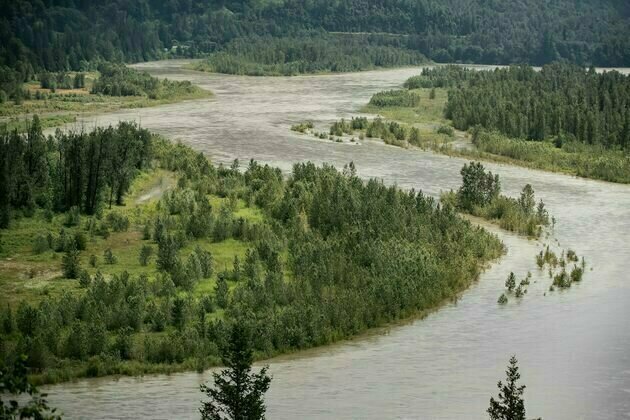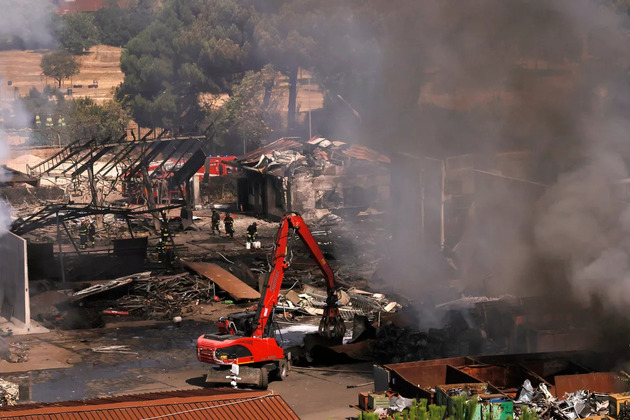Overuse of riprap to prevent riverbank erosion is harming B.C. rivers
The Conversation
07 Jul 2025, 16:16 GMT+10

Every spring, melting snow and heavy rainfall brings a higher risk of flooding and riverbank erosion to parts of Canada. Bank erosion is responsible for a significant portion of annual flood damage in Canada, with estimates suggesting the costs could grow as high as $13.6 billion anually by the end of the century.
In British Columbia, erosion is primarily managed by "hardening" riverbanks with large rocks called riprap. These rocks are so prevalent along B.C. rivers that you might think they are part of the natural environment, but they are not.
Hardened riverbanks offer temporary protection from river movement, but riprap can lead to degraded rivers. Erosion is a natural process that helps maintain healthy and diverse river habitat. However, as societies expand, there is more demand to control river movement and prevent erosion.
Through my work as a river scientist and flood risk researcher in New Zealand and Canada, I have witnessed the sometimes devastating impacts of river erosion and have also seen just how lifeless rivers can become when overly restricted.
Of course we need to protect people, property and infrastructure from riverbank erosion. But current erosion management is hurting B.C. rivers.
Riprap is essential for stabilizing riverbanks when infrastructure and property are at immediate risk. The rocks are often laid down as "temporary" erosion prevention before or during floods.
The problem is, if you harden one area with riprap, that bank transfers the erosion-hungry current elsewhere, driving the need for further riprap to be installed.
The exact impact that riprap is having on B.C. waterways requires more research, but professionals working in the province's rivers are already seeing the damage.
During a workshop I led with colleagues from Resilient Waters and Watershed Watch, we found that in a group of 83 river and flood management professionals, 53 had witnessed adverse impacts from riprap use in the province's Lower Mainland region.
It is now estimated that more than half of the gravel sections of the Fraser River have been hardened through riprap. To date, there has been limited consideration of the environmental consequences of such widespread bank hardening.
Riprap can bury the shallow spawning habitats preferred by many fish. It can prevent the "undercutting" of banks, a process that creates important spaces that salmon species prefer for shelter.
In addition, riprap causes water temperatures to rise as rocks trap heat from sunlight that would normally be shaded by riparian vegetation. That lack of vegetation also means less wood and debris in the rivers, which would normally add essential habitat complexity that is preferred by many fish species.
Riprap also acts as a potential migration barrier for salmon and other species trying to navigate the riverbanks. Finally, as riprap lessens available habitat for indigenous species, it can offer preferential habitat for invasive ones instead.
Given the potential for environmental harm, there have been calls to limit riprap use in British Columbia. Experts have suggested it should only be used in essential cases, ideally in river systems that are already heavily impacted by humans.
The good news is that there are bank-stabilizing alternatives to riprap.
Bioengineering involves using vegetation to create or support engineered structures. For example, live tree cuttings can be woven together to create wattles or brush mattresses. This process creates living tree walls and coverings that grow and strengthen over time.
Revegetation is another approach, using riparian planting to strengthen riverbanks with root systems. In some cases, this can be as simple as laying down seeds at the right time of year, often with other erosion control options like mulch terraces.
The key to the success of bioengineering and revegetation efforts is that they need to be done proactively. Unlike riprap, which can be installed as an emergency response measure, vegetation needs time to grow.
Is it possible to move on from our over-reliance on riprap in B.C.?
During our workshop, experts discussed what needs to happen to support environmentally friendly bank stabilization options.
First off, we need to be talking about the overuse of riprap more. Currently, decision-makers and property-owners are often unaware of the potential harm that riprap can have on our rivers, or that alternatives exist. While many alternatives won't be appropriate in extreme erosion cases, for the province's smaller and healthier rivers, they would be ideal.
For this to happen, the bank-stabilization regulation process in B.C. needs to change. Currently it is hard to receive consent or funding to undertake bank strengthening activities outside of emergency riprap installation.
The B.C. government needs to adapt local guidelines and regulations to allow wider use of alternative methods, prioritizing proactive bank strengthening. They can draw on findings from elsewhere in Canada where alternative bank-stabilization options are already being tested.
Shifting away from a dependence on riprap won't be easy, but in a province that relies on healthy rivers and fish, it should be a priority.
As one workshop attendee put it: "We don't want to see sterile kilometres of riprap."
 Share
Share
 Tweet
Tweet
 Share
Share
 Flip
Flip
 Email
Email
Watch latest videos
Subscribe and Follow
Get a daily dose of Massachusetts Sun news through our daily email, its complimentary and keeps you fully up to date with world and business news as well.
News RELEASES
Publish news of your business, community or sports group, personnel appointments, major event and more by submitting a news release to Massachusetts Sun.
More InformationInternational
SectionCongress weighs Medicaid cuts, sparking alarm in small-town hospitals
OMAHA, Nebraska: With Congress considering cuts totaling around US$1 trillion to Medicaid over the next decade, concerns are rising...
Gas station blast injures 40 in Rome, kids narrowly escape
ROME, Italy: Quick thinking by emergency responders helped prevent greater devastation after a gas station explosion in southeastern...
Weapons pause by Trump signals shift away from foreign wars
WASHINGTON, D.C.: President Donald Trump is drawing praise from his core supporters after halting key arms shipments to Ukraine, a...
Moscow removes Taliban from banned list, grants official status
MOSCOW, Russia: This week, Russia became the first country to officially recognize the Taliban as the government of Afghanistan since...
Netanyahu vows 'No Hamas' in postwar Gaza amid peace talks
CAIRO, Egypt: This week, both Hamas and Israel shared their views ahead of expected peace talks about a new U.S.-backed ceasefire plan....
US sends message by publicizing visa ban on UK punk-rap band
WASHINGTON, D.C.: The Trump administration has made public a visa decision that would usually be kept private. It did this to send...
Business
SectionTrump admin allows GE to restart engine sales to China’s COMAC
WASHINGTON, D.C.: The U.S. government has granted GE Aerospace permission to resume jet engine shipments to China's COMAC, a person...
Saudi Aramco plans asset sales to raise billions, say sources
DUBAI, U.A.E.: Saudi Aramco is exploring asset sales as part of a broader push to unlock capital, with gas-fired power plants among...
Russia among 4 systemic risk countries for Italian banks
MILAN, Italy: Italian regulators have flagged four non-EU countries—including Russia—as carrying systemic financial risk for domestic...
US debt limit raised, but spending bill fuels fiscal concerns
NEW YORK CITY, New York: With just weeks to spare before a potential government default, U.S. lawmakers passed a sweeping tax and spending...
Shein hit with 40 million euro fine in France over deceptive discounts
PARIS, France: Fast-fashion giant Shein has been fined 40 million euros by France's antitrust authority over deceptive discount practices...
Meta hires SSI CEO Gross as AI race intensifies among tech giants
PALO ALTO/TEL AVIV: The battle for top AI talent has claimed another high-profile casualty—this time at Safe Superintelligence (SSI),...













